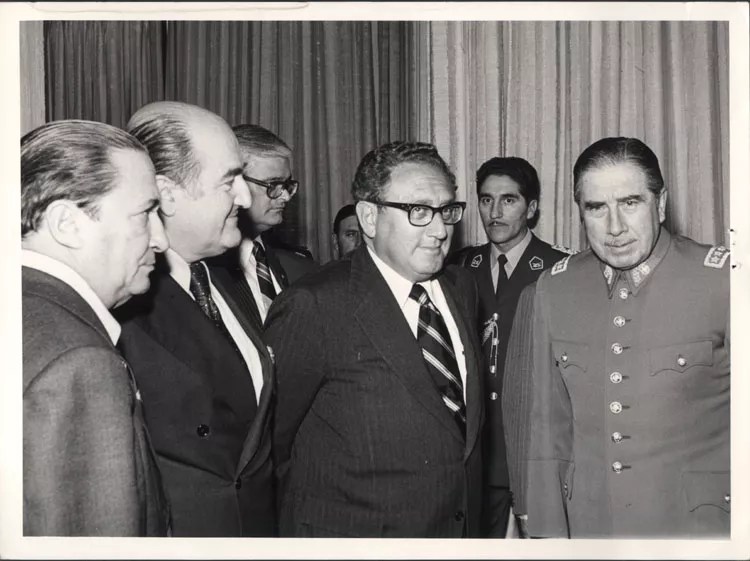
Photo courtesy of Wikimedia CC

Audio By Carbonatix
From the Bay of Pigs invasion to the overthrow of democratically elected Guatemalan president Jacobo Arbenz, some of the CIA’s darkest covert operations across Latin America have Miami connections.
Now, newly declassified documents show that the Magic City was almost a secret base for one of the bloodiest covert operations in Latin America, one that killed tens of thousands of people across a half-dozen countries.
The new documents show that the Gestapo-like Chilean secret police, or La Dirección de Inteligencia Nacional (DINA), wanted a U.S.-sanctioned base in Miami in the mid-’70s where operatives could carry out missions such as kidnappings and assassinations – a request that was at least considered by U.S. officials.
The report was included in a trove of more than 500 pages of declassified CIA documents ranging from the administrations of Gerald Ford to George H. W. Bush. The docs detail human rights abuses in Argentina and were released this past December 12 by the Office of the Director of National Intelligence.
We’re thankful for you. Are you thankful for us?
We feel thankful for our staff and for the privilege of fulfilling our mission to be an unparalleled source of information and insight in Miami. We’re aiming to raise $30,000 by December 31, so we can continue covering what matters most to this community.
Help us continue giving back to Miami.
One of those redacted reports details plans for a base to support activities related to Operation Condor, the codename for an “international consortium” of South American intelligence agencies founded in 1976 and secretly backed by the U.S. government.
Condor was based in Chile, whose president at the time was the brutal dictator Augusto Pinochet. But Condor was really a U.S.-backed “black operations” campaign, says Long Island University professor J. Patrice McSherry. Its purpose was to destroy political opposition to the South American military dictatorships – specifically in Argentina, Brazil, Chile, Paraguay, Uruguay, and Bolivia – propped up by Americans in the ’70s.
The right-wing militias targeted anyone suspected of sympathies to communism and killed as many as 80,000 people over two decades, according to the “Archives of Terror,” a cache of documents stemming from the operation that were unearthed by human rights activists in Paraguay in 1992.
Many others also disappeared. Jorge V. Sznaider, Jorge Perez Brancato, Hugo Maiosovsky, Noemi Graciela Beltone, Carlos Alberto Perez, and Mirta Silber de Perez, all 20-somethings who were holding a political discussion in their apartment in the late ’70s, were picked up by the police. They haven’t been heard from since the declassified report was first published August 3, 1979.
The secret police involved in Condor used torture, abductions, disappearances, and renditions to further their aims. One of the operation’s most dubious parts was “Phase III,” a highly secretive program that involved special teams traveling to foreign countries to carry out missions – including assassinations – against Condor enemies, the report states.
Such missions were carried out in 1974 when Gen. Joaquin Zenteno Anaya, a Bolivian ambassador to France, was killed by a car bomb in Paris. Two years later, an exiled Argentine ambassador to the U.S. named Orlando Letelier and an American citizen named Ronni Moffitt were assassinated with a car bomb along Embassy Row in Washington, D.C. It was later revealed that Pinochet had played a personal role in the murders.
Those are probably the kinds of missions that Condor’s brass hoped to carry out from its base in Miami. “The plot is relevant insofar as it provides evidence of Condor’s capabilities as well as its possible intentions in planning to open a station in Miami shortly afterward,” the report states.
Miami’s promixity to Latin America and access to the Cuban exile community made the city the perfect spot for DINA chief Manuel Contreras, who McSherry says wanted to connect Pinochet with Cuban exiles and other anti-Castro Cubans to carry out joint operations.
News of the Miami base was first reported by the Washington Post, which cited a classified U.S. Senate report in a August 9, 1979, article, “Foreign Spy Activity Found Rampant in U.S., the Chileans.” Using secondary sources, McSherry briefly covered it in her 2005 book, Predatory States.
However, the newly declassified documents are the first official proof of the Miami connection to the brutal secret war.
Knowledge of the base reached all the way to Secretary of State Henry Kissinger, who shot down the idea in messages that McSherry says were sent through covert channels rather than in a formal denunciation.
This is significant, McSherry says, because it demonstrates the U.S. government’s complicity in Condor.
“One surmises that the information is still sensitive because it indicates that Washington was not only well informed of Condor but also was an unofficial or top-secret sponsor of the cross-border system,” McSherry tells New Times.
When contacted, officials from the U.S. State Department declined to comment on the declassified documents, and several emails sent by New Times to Kissinger went unreturned.
Pinochet was never convicted of the human rights abuses he was accused of and spent his last days under house arrest in Chile. He died in 2006.
The entire set of declassified documents can be downloaded from the Office of the Director of National Intelligence’s Tumblr website.